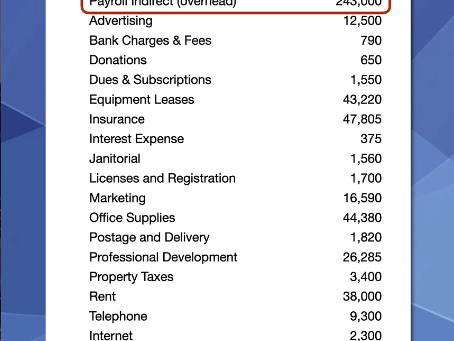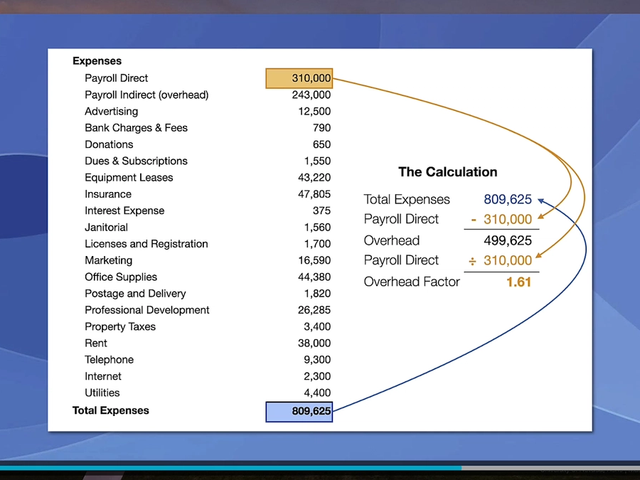KPI - Calculating Your Overhead (OH) Factor For AE Firms

The Overhead Factor lets you know exactly how much overhead you need to apply to each project.
Related Article: Using Your Overhead Factor
What You Need
The first thing you will need is a twelve-month profit and loss statement. Why twelve months? Some of your expenses only come once a year, and so we want to make sure that they get allocated across all the projects you work on.
You might have a short project that only lasts for three months during the year, but if, during those three months, none of your annual expenses came in, then they wouldn't be allocated to that job if you did this on a month-by-month basis. Every job needs to carry the total burden of a year in business.

In this example, we’ve included what usually goes into the expenses of the average AE firm. See what your expenses look like so you can get a good grasp of how you can apply this principle to your firm.
When calculating your overhead factor, look at your P&L statement and focus on your expenses. Make sure that your accounting software splits the payroll value into direct and indirect payroll.
Direct payroll is the wages you pay your employees for the time they spend working on projects you're getting paid for. Indirect payroll is the wages you pay your employees for time spent doing other activities.

Indirect payroll may include marketing, accounting, billing, client outings, being in the golf tournament or attending the barbecue, continuing education and professional development, holidays, vacation time or PTO time, or sick time. All of that is your indirect payroll because when they're doing those activities, they are not earning money for your firm.
As for health insurance, 401k match, etc. - they all fall into Indirect Payroll or Overhead to make everything simpler.
Watch This Video To Get More Information About How Calculating Your Overhead Factor
The Calculation
What we're going to do in the calculation is we're going to take our total expenses; let’s take this amount for example - let’s say you have $809,625 in Total Expenses, and we're going to subtract $310,000 worth of direct payroll to get our overhead cost of $499,625.
Once you have your $499,625 you're going to take that direct payroll amount and divide it in to get your overhead factor. So in this example, there's $1.61 of overhead for every dollar of direct labor, and that's about average for architects and engineers in the United States.

Your overhead factor might be different from the average $1.61. It could be higher or lower than that. And that's why you need to do the calculations. You need to know exactly what your Firm’s overhead factor is. We have clients that go as low as a dollar, and those that go as high as two dollars.
Then you can use this overhead factor to multiply times your direct labor on your project to calculate the overhead that the project needs to be burdened with and that once subtracted from your revenue, take the revenue, subtract your direct labor, subtract the overhead and that'll give you project by project net profits.
How BaseBuilders Can Help
If you happen to be one of our clients, you can put your overhead factor directly into the software and every time an employee records time, their direct labor and the overhead factor is applied to that time cost. So we're going to give you in real-time as your employees record their time, your direct cost, your overhead cost, and if you have revenues, it will calculate your net profits.
